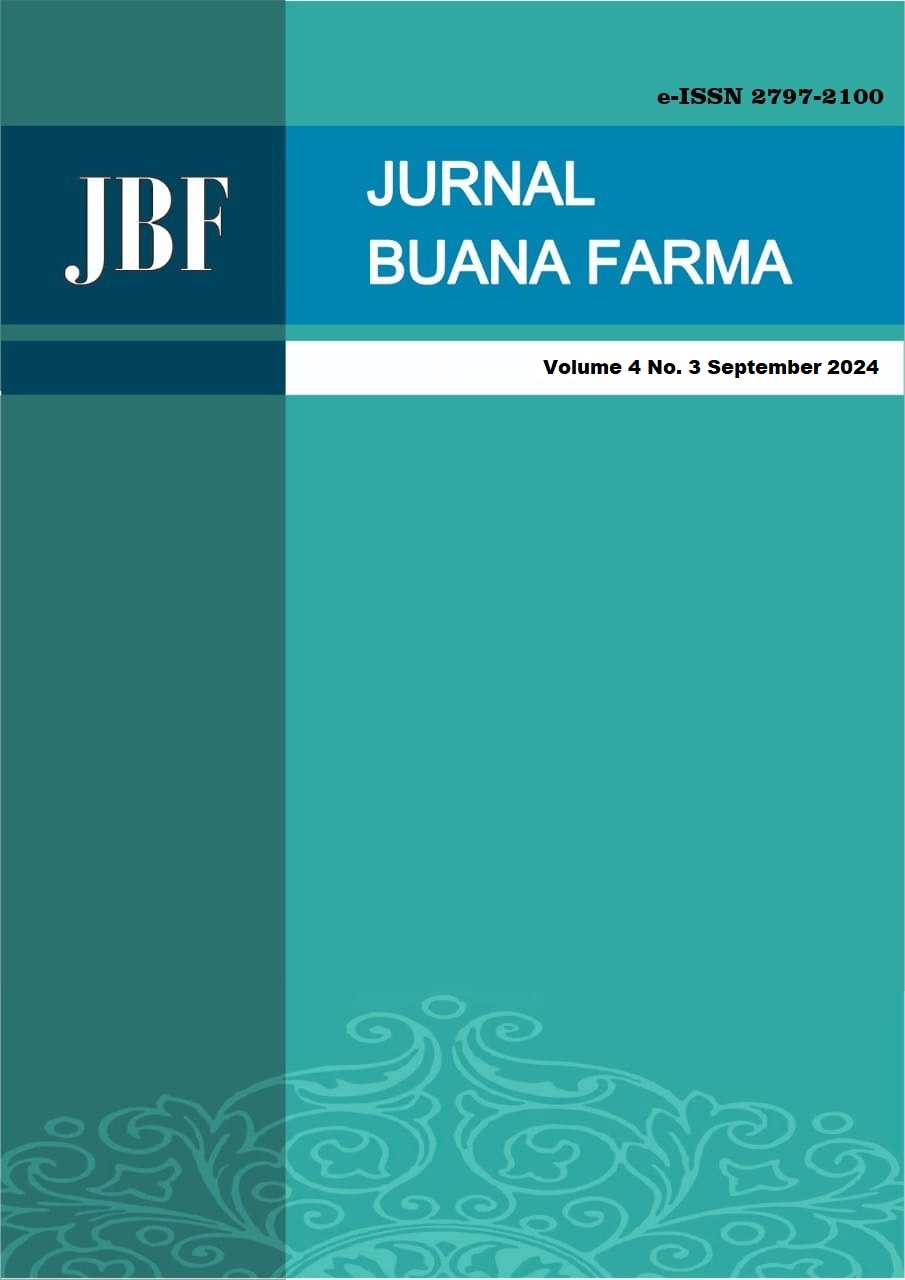PENGARUH METODE FERMENTASI TERHADAP PENINGKATAN KANDUNGAN KIMIA DAN AKTIVITAS FARMAKOLOGI PADA BEBERAPA TANAMAN: Artikel Review
Abstract
Fermentation is a process that involves the chemical transformation or breakdown of complex organic substances or other food components into simpler compounds through the action of natural enzymes and fermenting microorganisms. The purpose of this literature review is to explore the impact of fermentation methods on the enhancement of phytochemical content and pharmacological activity in various plants. Journal searches were conducted on Google Scholar, PubMed, and ScienceDirect. The results revealed that fermentation methods can increase the chemical content and pharmacological activity of a plant. Microorganisms that are frequently used in the fermentation process, such as Bacillus subtilis and actobacillus brevis, can increase the total phenol content and enhance antioxidant activity. Factors influencing the fermentation process in improving the chemical content and pharmacological activity of a plant include treatment methods, duration of fermentation (incubation), microorganisms used, and the concentration of inoculum used.
References
Ali, MW., Ilays, MZ., Saeed, MT., & Shin, DH. Comparative Assessment Regarding Antioxidative and Nutrition Potential of Moringa oleifera Leaves by Bacterial Fermentation. Journal of food science and technology. 2020; 57(3):110-1118.
Ali, MW., Shahzad, R., Bilal, S., Adhikari, B., Kim, ID., Lee, JD., & Shin, DH. Comparison of antioxidants potential, metabolites, and nutritional profiles of Korean fermented soybean (Cheonggukjang) with Bacillus subtilis KCTC 13241. Journal of food science and technology. 2018; 55: 2871-2880.
Anggraini, D., Fernando, A., & Elisa, N. (2018). Formulasi Losion Antioksidan Ekstrak Buah Stroberi (Fragaria Ananassa). Pharmaceutical Journal of Indonesia. 2018; 14(2): 153-161.
Berghofer, E., Grzeskowiak, B., Mundigler, N., Sentall, WB., & Walcak, J. Antioxidative properties of faba bean-, soybean-and oat tempeh. International journal of food sciences and nutrition. 1998; 49(1): 45-54.
Chen, CY., Hu, CY., Chen, YH., Li, YT., & Chung, YC. Submerged fermentation with Lactobacillus brevis significantly improved the physiological activities of Citrus aurantium flower extract. Heliyon. 2022; 8(9).
Dai, W., Qi, D., Yang, T., Lv, H., Guo, L., Zhang, Y., & Lin, Z. Nontargeted Analysis Using Ultraperformance Liquid Chromatography–Quadrupole Time-Of-Flight Mass Spectrometry Uncovers The Effects Of Harvest Season On The Metabolites And Taste Quality Of Tea (Camellia sinensis L.). Journal of Agricultural and Food Chemistry. 2015; 63(44): 9869-9878.
De Montijo-Prieto, S., Razola-Díaz, MDC., Barbieri, F., Tabanelli, G., Gardini, F., Jiménez-Valera, M., & Gómez-Caravaca, A. M. Impact of lactic acid bacteria fermentation on phenolic compounds and antioxidant activity of avocado leaf extracts. Antioxidants. 2023; 12(2): 298.
Fikayuniar, L., Gunarti, NS., & Apriliani, M. Uji aktivitas antibakteri ekstrak etanol rimpang kunyit (Curcuma longa L.) terhadap Staphylococcus aureus dan Pseudomonas aeruginosa. Pharma Xplore: Jurnal Sains dan Ilmu Farmasi. 2019; 4(1): 278-287.
Hwang, CE., Seo, WT., & Cho, KM. Enhanced Antioxidant Effect Of Black Soybean By Cheonggukjang With Potential Probiotic Bacillus subtilis CSY191. Korean Journal of Microbiology. 2013; 49(4): 391-397.
Harianto, I. K. Uji Daya Hambat Perasan Rimpang Kunyit (Curcuma longa L.) Terhadap Pertumbuhan Candida Albican. Pharmacon. 2017; 6(2): 1-6.
Li, X., Chen, Y., Lai, Y., Yang, Q., Hu, H., & Wang, Y. Sustainable Utilization of Traditional Chinese Medicine Resources : Systematic Evaluation on Different Production Modes. Evidence-based Complementary and Alternative Medicine. 2015; 1-10. https://doi.org/10.1155/2015/218901
Li, SW., Yuan, G., Deng, P., Wang, P., Yang, BB., Aggarwal. Chemical composition and product quality control of turmeric (Curcuma longa L.). Pharmaceuti Crops. 2011; 2: 28-54
Ma, Q., Noda, M., Danshiitsoodol, N., & Sugiyama, M. Fermented Stevia Improves Alcohol Poisoning Symptoms Associated with Changes in Mouse Gut Microbiota. Nutrients. 2023; 15(17): 3708.
Muñoz, R., de Las Rivas, B., de Felipe, FL., Reverón, I., Santamaría, L., Esteban-Torres, M., & Landete, JM. (2017). Biotransformation Of Phenolics By Lactobacillus plantarum In Fermented Foods. In Fermented foods in health and disease prevention (pp. 63-83). Academic Press.
Murelina, E. M., & Wijayanti, E. D. (2018). Perbandingan Kadar Fenolik Total Sari Rimpang Temu Giring (Curcuma heyneana) Segar dan Terfermentasi. JC-T (Journal Cis-Trans): Jurnal Kimia dan Terapannya, 2(2), 4-20.
Novitasari, R. Studi pembuatan sirup jeruk manis pasaman (Citrus sinensis Linn.). Jurnal Teknologi Pertanian. 2018; 7(2): 1-9.
Nugraha, AS., Agustina, RP., Mirza, S., Rani, DM., Winarto, NB., Triatmoko, B., Nugraha, A., Pratama, W., Keller, PA., & Wangchuk, P. Phytochemistry and Pharmacology of Medicinal Plants Used by the Tenggerese Society in Java Island of Indonesia. Molecules. 2022; 27(21): 7532.
Patala, R., Anggi, V., Paula, I., & Sakina, N. Aktivitas Analgesik dan Antiinflamasi Nanoemulsi Ekstrak Etanol Rimpang Kunyit (Curcuma longa L.) secara In Vivo. Journal of Pharmaceutical and Sciences. 2023; 6(4), 1795-1803.
Pogačar, MŠ., Turk, DM., & Fijan, S. Knowledge of fermentation and health benefits among general population in North ‑ eastern Slovenia. BMC Public Health. 2022; 22(1): 1–11. https://doi.org/10.1186/s12889-022-14094-9.
Pradipta, IS., Aprilio, K., Febriyanti, RM., Ningsih, YF., Andhika, M., Pratama, A., Indradi, RB., Gatera, A., & Alfian, SD. Traditional medicine users in a treated chronic disease population : a cross ‑ sectional study in Indonesia. BMC Complementary Medicine and Therapies. 2023; 23(120): 1–9. https://doi.org/10.1186/s12906-023-03947-4
Prihardini, P., & Basuki, DR. Uji Aktivitas Antianemia Ekstrak Etanol Dan Perasan Rimpang Kunyit (Curcuma Longa Linn.) Ditinjau Dari Peningkatan Kadar Haemoglobin Dan Eritrosit Pada Tikus Galur Wistar Dengan Pengindukasi NaNO2 Secara In Vivo. Jurnal Wiyata: Penelitian Sains dan Kesehatan. 2020; 6(2): 117-127.
Ramadhanil, R., & Elijonnahdi, E. Aplikasi Ilmu Biologi Dalam Pendidikan dan Pembangunan Berwawasan Lingkungan Berbasis Sumberdaya Alam. Biocelebes. 2011; 5(2): 105-116
Rizkayanti, R., Diah, AW. M., & Jura, MR. (2017). Uji aktivitas antioksidan ekstrak air dan ekstrak etanol daun kelor (Moringa oleifera LAM). Jurnal Akademika Kimia. 2017; 6(2): 125-131.
Sanjukta, S., Rai, AK., Muhammed, A., Jeyaram, K., & Talukdar, NC. Enhancement Of Antioxidant Properties Of Two Soybean Varieties Of Sikkim Himalayan Region By Proteolytic Bacillus subtilis fermentation. Journal of Functional Foods. 2015; 14: 650-658.
Sari, B. M. Identifikasi Tingkat Kematangan Buah Stoberi Berdasarkan Warna RGB dengan Menggunakan Metode Regionprops. TIN: Terapan Informatika Nusantara. 2020; 1(5): 225-230.
Septiana, E., & Simanjuntak, P. Aktivitas Antimikroba Dan Antioksidan Ekstrak Beberapa Bagian Tanaman Kunyit (Curcuma longa). Fitofarmaka: Jurnal Ilmiah Farmasi. 2015; 5(1): 1-10.
Sulasiyah, S., Sarjono, PR., & Aminin, AL. Antioxidant from turmeric fermentation products (Curcuma longa) by Aspergillus oryzae. Jurnal Kimia Sains dan Aplikasi. 2018; 21(1): 13-18.
Suprihatin, T., Rahayu, S., Rifa'i, M., & Widyarti, S. Senyawa pada serbuk rimpang kunyit (Curcuma longa L.) yang berpotensi sebagai antioksidan. Buletin Anatomi dan Fisiologi. 2020; 5(1): 35-42.
Susanty, S., Yudistirani, SA., & Islam, MB. Metode Ekstraksi Untuk Perolehan Kandungan Flavonoid Tertinggi Dari Ekstrak Daun Kelor (Moringa Oleifera Lam). Jurnal Konversi. 2019; 8(2): 6.
Wang, Y., Wu, J., Lv, M., Shao, Z., Hungwe, M., Wang, J., & Geng, W. Metabolism characteristics of lactic acid bacteria and the expanding applications in food industry. Frontiers in bioengineering and biotechnology. 2021; 9: 612285.
Wijayanti, ED., & Setiawan, NCE. The Effect Of Lactic Acid Fermentation On Fig (Ficus carica) Fruit Flavonoid. Berkala Penelitian Hayati Journal Of Biological Researches.2017; 23(1): 39-44.
Xiao, L., Yang, C., Zhang, X., Wang, Y., Li, Z., Chen, Y., et al. Effects of solid-state fermentation with Bacillus subtilis LK-1 on the volatile profile, catechins composition and antioxidant activity of dark teas. Food Chemistry: X. 2023; 19: 100811.
Yang, W., Liu, J., Liu, H., Zhang, Q., Lv, Z., & Jiao, Z. Characterization of stoberi purees fermented by Lactobacillus spp. based on nutrition and flavor profiles using LC-TOF/MS, HS-SPME-GC/MS and E-nose. LWT. 2023; 189: 115457.













